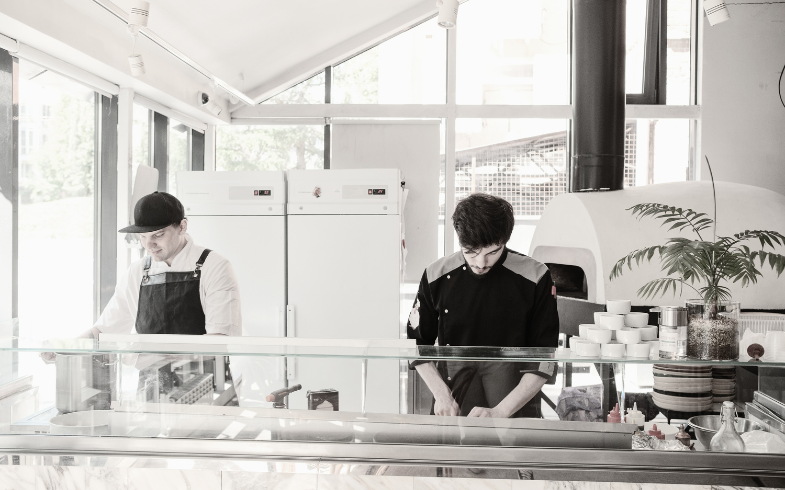Did you know that the FASOS, Biryani by Kilo, and many other famous brands are just cloud kitchens and are not typical restaurants? Are you curious about what are they, their working and business model? Well, they are cloud kitchen, and further you’ll find the brief about them.
For those who are not aware of cloud kitchens, unlike traditional brick-and-mortar establishments, allow food enterprises to make and deliver culinary goods with low overhead. It is a format where kitchens are delivery-only kitchens and these kitchens can be owned by a brand or third party working with various other brands.
Global Trend
A recent Gartner forecast suggests that with a 30% rise from 2021, public cloud implementation will reach $7.3 billion in 2022. The global cloud kitchen market is fragmented with the presence of many major players. The key players of the market like Door Dash, Inc., Kitchen United, Rebel Foods, and Kitopi are also profiled with their financial information and respective business strategies Country Coverage over North America, Europe, Asia.
There are a few reasons behind such a rise in demand. The shift to the cloud has been happening for a while, at a much lower rate pre-pandemic. But it got its due traction very recently since the onset of the pandemic and its related restrictions that evolved the market dynamics.
National Trend
According to research, cloud kitchens are set to be a $2 billion industry in India by 2024, up from $400 million in 2019.
First Cloud Kitchen
Food truck delivery services gave birth to the cloud kitchen concept. The food truck industry began to gain traction as a result of evolving technologies, and customers began ordering food through internet channels. Many organizations that just provided food, started establishing cloud kitchens soon after.
Different Business Models
The cloud kitchen has several advantages such as lower investment, easy expansion opportunities, increased efficiency, multiple brands under one roof, etc. and is majorly divided into two segments: kitchen type (independent model, shared model & aggregator managed model) and delivery type (delivery only & delivery and takeaway).

Cloud kitchens are operated on several different models as follows:
Single-brand cloud kitchen: Single brand, single kitchen and no storefront
The most common type of cloud kitchen is an independent cloud kitchen, in which a virtual restaurant runs without a physical storefront accessible to consumers. They focus solely on a single cuisine. Foods prepared in such a facility can only be sold via online delivery applications.
Multi-brand cloud kitchen: Multiple brands and cuisines, a single kitchen, and no storefront.
This is a tech-focused cloud kitchen concept in which a single mother brand manages several food brands, each specializing in a high-demand cuisine. Each brand is intentionally positioned as a standalone restaurant that specializes in a certain dish or cuisine. In this delivery kitchen model, only online orders are accepted, and food is delivered.
The hybrid cloud kitchen: Single brand, single kitchen, and multiple outlets with a storefront.
This model differs slightly from an actual cloud kitchen model. It’s a hybrid cloud kitchen with a single food brand operating out of a physical location. Customers can only purchase meals from such a kitchen if they want to take it home or place an order online.
Delivery app owned ‘shell kitchen’: Aggregator owned, multiple restaurant brands, rented co-working kitchens, no storefront
This is a one-of-a-kind cloud kitchen model built on an aggregator. In this model, numerous restaurants can operate under one roof. This type of cloud kitchen functions as a commercial kitchen area where new or existing restaurants can rent a kitchen and work alongside other restaurants. Only an empty kitchen space with basic infrastructure is provided by the owner delivery app. ‘Shell kitchen’ is another name for it.
Delivery app owned fully stacked cloud kitchen: Aggregator owned, multiple restaurant brands, rented kitchens, with a storefront
This cloud kitchen model also includes a commercial kitchen. Multiple businesses collaborate in a single fully equipped kitchen run by the proprietor of a delivery app They provide not only the kitchen space, but also customized cooking stations, cooking equipment, and other essential facilities to optimize the meal preparation process. The restaurants will only need to rent a kitchen facility for the duration of their operation, and they will be given an online presence on the owner delivery app, where clients can place orders.
Fully outsourced cloud kitchen: Cooking and delivery are fully outsourced
The notion of an outsourced cloud kitchen is an innovative one in which the majority of the food preparation is done in a centralized cloud kitchen. The partner restaurant, on the other hand, adds the finishing touches to the dish, which is subsequently supplied through the cloud kitchen owner brand. The food is picked up from the restaurant once it is ready, and the order is delivered by the cloud kitchen firm.
Fully outsourced cloud kitchen: Cooking and delivery are fully outsourced
Multiple restaurants can rent a cloud kitchen from a single organization in the co-working cloud kitchen space.
These many kitchen spaces are thoughtfully placed, with separate kitchen units for each brand, each with the necessary kitchen
amenities and fully equipped.
Challenges that cloud kitchen operators are facing right now or might face in future
The cloud kitchen is a new industry vertical and so there are fewer standardization in this sector which leads to many challenges that the kitchen operators face right now:
1. One of the most common mistakes businesses make is underestimating the amount of working capital needed to run a cloud kitchen restaurant. The largest issue in the cloud kitchen industry is not the initial expenditures, but the enormous financial backing required to scale operations and expand market share.
2.Maintaining consistency standards to enhance customer retention and developing brand loyalty among customers
3.The cloud kitchen also lacks in defining and creating the Standard Operating Procedures (SOP)
4.Geography constraints as a single location typically can serve only a 3- to the 5-mile delivery radius.
5.Ghost kitchen operators also have little control over the quality of last-mile deliveries which can affect their reputations.
Future of Cloud hospitality/Kitchen in India
Cloud kitchens are a technology-first play, which means that while amazing cuisine is important for a cloud kitchen firm, knowing customers is even more important for long-term success. Understanding the unit economics of the delivery app relationship and the cost of menu item procurement is important to the success of a cloud kitchen business. Restaurant owners must know what their clients enjoy and dislike, as well as anticipate what they will order at different times. The more technologically oriented a cloud kitchen business is, the faster or greater the ROI will be.
Many thought that during and post-pandemic the food industry would face the most impact and would have difficulty in surviving, but the rise and pivoting to cloud kitchen helped the restaurant owners not only survive but grow in these times.
Author:
 Sr. Business Analyst at J.hirani, MBA from Ahmedabad University. She is an introverted person who likes to listen to a podcast and cook different cuisine. You’ll either find her laughing at silly stand-ups or indulged in a drama or a book.
Sr. Business Analyst at J.hirani, MBA from Ahmedabad University. She is an introverted person who likes to listen to a podcast and cook different cuisine. You’ll either find her laughing at silly stand-ups or indulged in a drama or a book.
About J.hirani: J.hirani is a Strategic Transformation team which works as a growth partner for different organisations in various industries by providing services like Agile transformation, Scenario mapping, Strategic alignment, Balance scorecard, Digital transformation, Incubating new ventures, Operation excellence and Aligning human capital.
©J.hirani, The future of Cloud Kitchen, Feb 2022. All rights reserved



